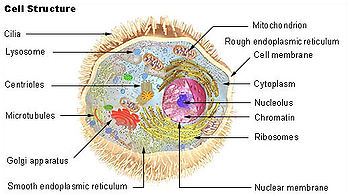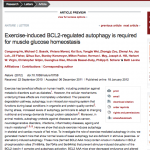Yesterday, I wrote about how stem cells might some day offer heart patients a mulligan.
But even the most optimistic optimist would agree that realizing this dream is futuristic. For now, and the near future, we have to play them where they lie. In real-life, do-overs for heart attacks and strokes happen only on rare occasions. Thus, it’s best to hit them straight and true the first time. Think prevention.
This leads me right back to the safest and most effective treatment for heart disease; no, check that, all diseases.
Ah. Of course, it’s Wednesday after all.
Exercise does so much. It…
makes us tingle with delight,
keeps us thin and sexy,
strong and vital,
smart and witty,
more resistant to disease and stress,
and mostly, just plain happy.
 But did you ever wonder how exercise really does all this? How does the stress of pedaling, running, swimming, and even triathlon-ing work at the basic level—in our cells. For it is true, as we learned in 7th grade, we are just a big bag of cells.
But did you ever wonder how exercise really does all this? How does the stress of pedaling, running, swimming, and even triathlon-ing work at the basic level—in our cells. For it is true, as we learned in 7th grade, we are just a big bag of cells.
 A recent paper published in the basic science journal, Nature, sheds some light on how exercise may act at the cellular level. I found it a pretty cool read.
A recent paper published in the basic science journal, Nature, sheds some light on how exercise may act at the cellular level. I found it a pretty cool read.

Here’s the skinny: As background, and I’m sorry to keep bringing up 7th grade bio, you will have to recall that dreaded cell project. (Mine was a sponge cake that Mom made.) Though 99.99% of us have forgotten this fact, one of the cell parts you (or your mom) colored in was the lysosome—a bag in the cell that cleans and recycles waste products. Biologists call this self-cleansing process autophagy, and it’s important in preventing cell death (aging), fighting infection and balancing the good and bad aspects of inflammation—the root cause of heart disease.
During stress, a cell’s capacity to increase recycling and clearing of toxins might be a good thing for its survival. And here is where exercise comes in. The pre-experiment thinking (hypothesis) was that exercise increases a cell’s ability to self-cleanse–autophagy, which in turn helps it manage stressful stimuli.
The experiment was cool. Scientists from Texas were able to genetically engineer mice that could not increase autophagy in response to exercise. The mutant mice were slackers; they showed lesser exercise capacity and a greater sensitivity to high-fat foods. (Sound like a familiar problem in Western society?)
The researchers concluded that exercise induces cell autophagy and this enhanced self-cleaning action may help cells better withstand stress and fight disease.
So there you have it. Yet another reason to celebrate a beautiful ride.
Badder-ass cells!
JMM
One reply on “Cycling Wednesday: How exercise ‘hardens-up’ our cells…”
I found this video on Youtube (http://www.youtube.com/watch?v=aUaInS6HIGo) that talked about the benefits of exercise. Overall it’s a lot of information presented in an entertaining way. You have to overlook the fact that he said that exercise cures death a couple of times. But it is still a good video.